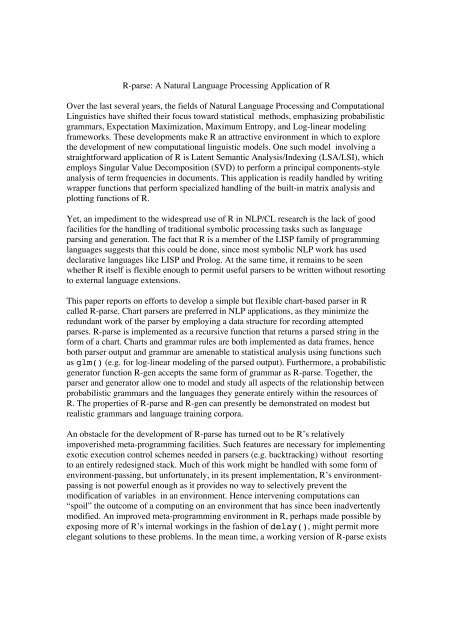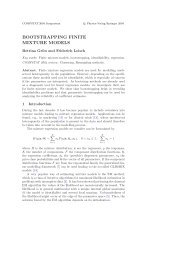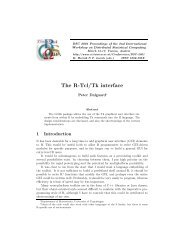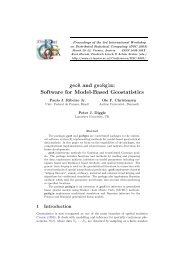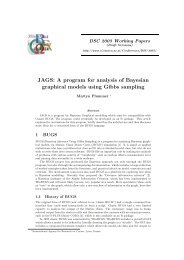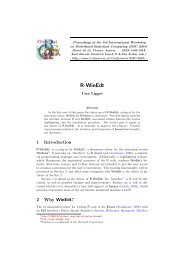Embedding R in Windows applications, and executing R remotely
Embedding R in Windows applications, and executing R remotely
Embedding R in Windows applications, and executing R remotely
You also want an ePaper? Increase the reach of your titles
YUMPU automatically turns print PDFs into web optimized ePapers that Google loves.
R-parse: A Natural Language Process<strong>in</strong>g Application of R<br />
Over the last several years, the fields of Natural Language Process<strong>in</strong>g <strong>and</strong> Computational<br />
L<strong>in</strong>guistics have shifted their focus toward statistical methods, emphasiz<strong>in</strong>g probabilistic<br />
grammars, Expectation Maximization, Maximum Entropy, <strong>and</strong> Log-l<strong>in</strong>ear model<strong>in</strong>g<br />
frameworks. These developments make R an attractive environment <strong>in</strong> which to explore<br />
the development of new computational l<strong>in</strong>guistic models. One such model <strong>in</strong>volv<strong>in</strong>g a<br />
straightforward application of R is Latent Semantic Analysis/Index<strong>in</strong>g (LSA/LSI), which<br />
employs S<strong>in</strong>gular Value Decomposition (SVD) to perform a pr<strong>in</strong>cipal components-style<br />
analysis of term frequencies <strong>in</strong> documents. This application is readily h<strong>and</strong>led by writ<strong>in</strong>g<br />
wrapper functions that perform specialized h<strong>and</strong>l<strong>in</strong>g of the built-<strong>in</strong> matrix analysis <strong>and</strong><br />
plott<strong>in</strong>g functions of R.<br />
Yet, an impediment to the widespread use of R <strong>in</strong> NLP/CL research is the lack of good<br />
facilities for the h<strong>and</strong>l<strong>in</strong>g of traditional symbolic process<strong>in</strong>g tasks such as language<br />
pars<strong>in</strong>g <strong>and</strong> generation. The fact that R is a member of the LISP family of programm<strong>in</strong>g<br />
languages suggests that this could be done, s<strong>in</strong>ce most symbolic NLP work has used<br />
declarative languages like LISP <strong>and</strong> Prolog. At the same time, it rema<strong>in</strong>s to be seen<br />
whether R itself is flexible enough to permit useful parsers to be written without resort<strong>in</strong>g<br />
to external language extensions.<br />
This paper reports on efforts to develop a simple but flexible chart-based parser <strong>in</strong> R<br />
called R-parse. Chart parsers are preferred <strong>in</strong> NLP <strong>applications</strong>, as they m<strong>in</strong>imize the<br />
redundant work of the parser by employ<strong>in</strong>g a data structure for record<strong>in</strong>g attempted<br />
parses. R-parse is implemented as a recursive function that returns a parsed str<strong>in</strong>g <strong>in</strong> the<br />
form of a chart. Charts <strong>and</strong> grammar rules are both implemented as data frames, hence<br />
both parser output <strong>and</strong> grammar are amenable to statistical analysis us<strong>in</strong>g functions such<br />
as glm() (e.g. for log-l<strong>in</strong>ear model<strong>in</strong>g of the parsed output). Furthermore, a probabilistic<br />
generator function R-gen accepts the same form of grammar as R-parse. Together, the<br />
parser <strong>and</strong> generator allow one to model <strong>and</strong> study all aspects of the relationship between<br />
probabilistic grammars <strong>and</strong> the languages they generate entirely with<strong>in</strong> the resources of<br />
R. The properties of R-parse <strong>and</strong> R-gen can presently be demonstrated on modest but<br />
realistic grammars <strong>and</strong> language tra<strong>in</strong><strong>in</strong>g corpora.<br />
An obstacle for the development of R-parse has turned out to be R’s relatively<br />
impoverished meta-programm<strong>in</strong>g facilities. Such features are necessary for implement<strong>in</strong>g<br />
exotic execution control schemes needed <strong>in</strong> parsers (e.g. backtrack<strong>in</strong>g) without resort<strong>in</strong>g<br />
to an entirely redesigned stack. Much of this work might be h<strong>and</strong>led with some form of<br />
environment-pass<strong>in</strong>g, but unfortunately, <strong>in</strong> its present implementation, R’s environmentpass<strong>in</strong>g<br />
is not powerful enough as it provides no way to selectively prevent the<br />
modification of variables <strong>in</strong> an environment. Hence <strong>in</strong>terven<strong>in</strong>g computations can<br />
“spoil” the outcome of a comput<strong>in</strong>g on an environment that has s<strong>in</strong>ce been <strong>in</strong>advertently<br />
modified. An improved meta-programm<strong>in</strong>g environment <strong>in</strong> R, perhaps made possible by<br />
expos<strong>in</strong>g more of R’s <strong>in</strong>ternal work<strong>in</strong>gs <strong>in</strong> the fashion of delay(), might permit more<br />
elegant solutions to these problems. In the mean time, a work<strong>in</strong>g version of R-parse exists


